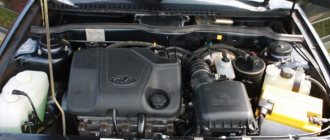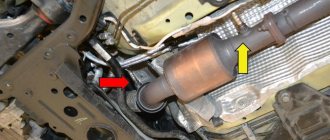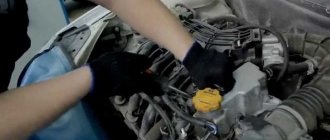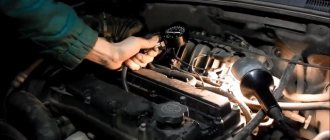It is useful for any fan of the domestic automobile industry to know the reasons why the Priora engine has 16 valves. After all, this problem is quite common. Ask any driver what the reason is, he will immediately give several options for the malfunction. And also ways to solve them. Of course, by interviewing many people you can find out all the reasons. But they still need to be checked. In addition, very often the cause of engine tripping can be several conditions at once. To ensure that the problem is resolved, you need to check all possible options. Only in this case will you get rid of this problem.
Signs of engine tripping
If the Priora’s engine starts to stall, it’s hard not to notice; the car will show the following signs of a malfunction:
- Loss of vehicle traction;
- Gases will come out of the exhaust pipe unevenly, and small pops will be heard;
- On the dashboard, the “CheckEngine” lamp will initially flash, and then remain on. The engine control unit will record an error about misfire in a certain cylinder.
- The engine will take longer to start or you will need to press the gas pedal to start the engine;
If your car shows such signs of malfunction, then most likely one of the cylinders in the car is not working.
Sensors
Engine friction can be caused by 2 sensors. One of them is the idle speed sensor. If he makes a mistake, the engine will stall when cold. After warming up everything returns to normal. The problem may also be caused by the crankshaft position sensor. Usually the problem with it is visible during diagnosis.
Conclusion
. There are many engine-related malfunctions. At the same time, even seemingly harmless ones can cause a bunch of other problems. Therefore, it is important to know all the reasons why the Priora 16-valve engine triples. This will help you quickly eliminate the problem, which significantly reduces engine life. It also brings closer the need for major repairs.
After the races, such nonsense began: at idle the car was shaking, the exhaust was dark (as if it was overflowing) BUT the check light did not light up. Fuel consumption is probably 30 liters per 100. I unscrewed the spark plugs - the carbon deposits are just crazy - the spark plugs are all black. I changed the spark plugs and installed Bosch platinum - no effect =( The engine doesn’t stall at speed, but when you sharply let off the gas, it almost stalls. The revs drop to 400-500 until you rev it up... I turned off the mass air flow sensor - a slight drop in revs for a split second - then it continues to stall. Who? what can you recommend?
PS I myself understand perfectly well that you need to go for diagnostics =) I just want to listen to advice - you never know who has had such a sore...
Why does the engine troit?
Engine trouble occurs for several reasons, and sometimes these reasons together can cause the failure of any of the cylinders.
Causes:
- Injectors;
- Spark plug;
- Ignition coils;
- Hydraulic compensators;
- valves;
- Compression;
All of the above details are ways to influence engine tripping. Let's look at each of the reasons in more detail.
Spark plug
Most often, the engine may stall due to worn spark plugs. Since spark plugs are installed in the combustion chamber and are exposed to high temperatures, they often fail, which leads to misfire in the cylinder in which the spark plug failed.
If your car has misfires, the first thing you need to do is check the spark plugs, and it is best to replace them with new ones.
Ignition coil
To provide the engine with a spark, Priora uses individual ignition coils for each cylinder, that is, the ignition coil is installed directly on the spark plug.
Since the ignition coil is made of plastic, exposed to high temperatures over time, its insulation cracks, which leads to breakdown of the insulation and leakage of the spark to the engine body. Also, at high temperatures, the coil winding can melt and short-circuit, which leads to coil failure and, consequently, misfire.
Injectors
Fuel injectors, as well as spark plugs, are installed near the combustion chamber and supply fuel through valves into the chamber. When the injector becomes dirty, the fuel supply to the combustion chamber is not supplied in the required volume or is not supplied at all, this leads to misfire.
Hydraulic compensators
In the Priora, namely the 16-valve engine, instead of shims on the valves, there are hydraulic compensators that adjust the gap between the camshaft and the valve automatically using oil pressure. With high mileage, cars have problems with the operation of this part; the hydraulic valves begin to knock and soon cannot open the valve at all, which leads to misfires in this cylinder.
valves
Sometimes it happens that the valves are to blame for engine throttling, namely, when a valve burns out, a small dimple appears in it, which allows compressed gases to pass through, which does not allow the mixture to ignite normally. For this reason, misfires may occur in the Priora engine.
Compression
With high mileage, the car engine wears out and thereby loses its compression. As in the case of valves, the gases are not compressed enough, thereby not forming a good fuel mixture.
Nutrition
A missed flash may occur due to the fact that there is simply nothing there to burn, that is, to flash. So first, start the engine. When it has been running for a couple of minutes, turn it off and remove the spark plug. If it turns out to be dry, then the reason is the lack of fuel. There may be several reasons for this situation:
- The most common cause of 16 valves on a Priora is damage to the injector winding. You can check this by removing the cover and manifold. Then measure the resistance on the injector winding; it should be within 15-15 Ohms. If it is faulty, it should be replaced. Read more about how to do this in the article “How to check an injector nozzle”;
- Another reason is a clogged injector. This usually happens when using low-quality fuel. You can also “clog” these engine elements yourself by pouring various cleaners into the tank. They partially destroy sediments. Which, in the form of a suspension, enter the injector, where they get stuck in the nozzles. To fix the problem, you need to flush the injectors. You can do this yourself without removing them from the engine.
Troubles when pressing the gas pedal sharply
When the Priora engine stalls when the throttle is opened sharply, this indicates a breakdown of the insulation of the individual ignition coils. The IKZ has rubber seals that isolate the cap of the coil and spark plugs, thereby preserving the spark from breakdown; when this cap wears out or is damaged, the spark can go to the engine body, thus, when the gas pedal is pressed sharply, it will pierce the body, which is why the internal combustion engine will triple.
Air supply
Normal air supply is the key to the formation of an air-fuel mixture and a normal combustion process. Thus, a malfunction of one or more air supply elements can lead to the engine starting to choke. These include the air filter and throttle valve.
Contamination of air elements is the reason why a car stalls..
The air filter element must be changed every 20,000 km, since after this it becomes clogged and becomes unusable.
But it is necessary to monitor the condition of the throttle valve, since it is unknown when it will become clogged and begin to cause problems. Typically, motorists clean this unit themselves, using special products or a carburetor cleaner.
Summary
So, we looked at why the car is tripping. These are not all possible reasons, but they help to accurately diagnose the operation of the motor and find the malfunction.
Comrades, help out! The situation is this, I have a Priora, 1.6 16 valves, the engine starts to stall after the car warms up... It works fine when cold. The BC shows misfire errors, and in all cylinders it is chaotic... I changed the spark plugs, there are new ones... BUT, if you disconnect the block from the mass air flow sensor, the tripping goes away, it works like a clock without the mass air flow sensor, the speed is kept around 840 at idle and misfire errors do not appear... So I drove it for 2 weeks, I thought there was a problem with the mass air flow sensor, but today I installed a known working mass air flow sensor, taken from another Priora, in which everything is fine, but the situation has not changed, it’s the same... Where to look?
An example of computer diagnostics of a VAZ 2110
| Many people believe that diagnosing a VAZ or foreign car is not a complicated procedure, and that it is enough to have the necessary equipment at hand. In fact, an experienced and competent specialist is the main component of this process. To show what high-quality diagnostics of a VAZ with your own hands looks like, we propose to consider one such example, when many car services were powerless in the face of a problem. |
VAZ 2110, 1.6l 8kl, January 7.2, Euro-2.
The owner of the car more than once contacted various car services with his problem (the engine was very rough), where there was no real help. As a result, when the car simply stopped moving, it was dragged on a tie to the nearest service center, where the ignition coil was replaced, but the trouble remained. We connect it to the scanner, where we see the following errors: In the “Misfire” tab, for some reason it shows misfires in the 4th cylinder: We try to ask for errors, the picture becomes even more interesting: We reset the ECU and again it shows differently: Stop fooling around, let’s diagnose. As usual, we connect a motor tester, a vacuum sensor at the intake, connect to the DPKV, a synchronization sensor on the wire of the 1st cylinder and capacitive sensors on the explosive wires. A test for the efficiency of the cylinders showed that at idle speed the 1st cylinder almost does not work , but it starts working when the gas is released. It looks like a problem with compression, due to losses in the CPG, the cylinder has less recoil and pushes the crankshaft weaker, when adding speed, these losses are not so noticeable and the cylinder can have recoil equal to the others. But it should be taken into account that this phenomenon usually occurs only in the early stages of burnout and valve leakage. And in the bar-graph “Relative compression” these losses are immediately visible, in this case they are not visible in the 1st cylinder. An example of the lag of the 3rd cylinder due to losses in the CPG is in the picture below: Could it be an underfilled injector? No, if the injector doesn’t flow, then it doesn’t flow at all speeds and compression has nothing to do with it either: Is there a problem in the ignition system? No, there are rather possible options here - when misfires occur under load while driving or sudden throttling on the spot (Priora, individual coil): Dead spark plug or coil with shorted turns (non-functioning 2nd cylinder due to a problem in the ignition system) : xn--2111-43da1a8c.xn--p1ai
Replacing spark plugs yourself
Replacing spark plugs on a Lada
Since faulty spark plugs occur most often during acceleration failures, auto mechanics recommend Lada Priora owners learn how to change this element of the ignition system themselves. This should be done after the car has traveled 20 thousand km. However, if the engine starts to trip, the spark plugs should be replaced before this date:
- Initially, you will need to clean the engine compartment from dirt and debris,
- Next, it is necessary to dismantle the engine elements to gain unhindered access to the spark plugs. Adapters and extensions are used for this. Before performing this work, you will need to wait until the engine has completely cooled down.
- The spark plugs are unscrewed one by one, and the high-voltage wires are disconnected. To prevent an accident, you must first remove the battery from the car. Otherwise, electricity may be supplied. When performing this procedure, it is recommended to monitor the force applied. It is better to seek help from specialists if the candle does not budge.
- To prevent debris from getting into the resulting holes, you need to cover them,
- The candles are screwed in manually at the first stage. Next, they are tightened using a special mechanism that allows you to measure the amount of force applied,
- high voltage wires are connected,
- engine operation is checked,
- The previously dismantled elements are assembled in the reverse order.
To ensure stable engine operation, spark plugs should be replaced regularly.
Lada Priora is the leader among domestic cars; sales of modern vehicles are breaking records. Among the advantages of the Priora, the owners note a good engine, which has better dynamics compared to other Lada models; the interior is also very comfortable. However, it is not without problems, for example, an engine designed for 8 or 16 valves often suffers from problems.











